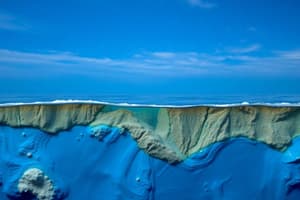Podcast
Questions and Answers
Which instrument is used to determine the depth of the ocean?
Which instrument is used to determine the depth of the ocean?
- Sonar
- Echo sounder (correct)
- Multibeam
- Radar
What is the continental shelf?
What is the continental shelf?
- A deep, flat sea floor
- A steep gradient that leads to the ocean floor
- A gently rising base
- A gently sloping submerged portion of the continental margin (correct)
What is the source of minerals obtained from the sea?
What is the source of minerals obtained from the sea?
- Rain
- River runoff
- Volcanic eruptions
- Seawater evaporating (correct)
Flashcards are hidden until you start studying
Study Notes
Introduction to Oceanography
- The Earth’s surface is 71% water and 29% land, with 140 million miles of water and 58 million miles of land.
- The northern hemisphere has more land than the southern hemisphere, with a 39% land and 61% water distribution compared to 19% land and 81% water.
- An echo sounder is an instrument used to determine the depth of the ocean, while a multibeam has not fully mapped out the ocean due to its vastness and cost.
- The continental margin is the portion of the seafloor adjacent to the continental shelf, slope, and rise, with the continental shelf being a gently sloping submerged portion of the continental margin, the continental slope being a steep gradient that leads to the ocean floor, and the continental rise being a gently rising base.
- An active margin is a narrow, deformed sediment, subducted continental margin, while a passive margin has a continental shelf, slope, and rise.
- Submarine canyons form through turbidity currents, while atolls are remains of a volcanic peak covered with coral.
- Seamounts are isolated volcanic peaks that rise at least 3,000 ft above the ocean floor, while guyots are submerged flat-topped seamounts, and abyssal plains are deep, flat sea floors.
- Terrigenous sediments are derived from terrestrial weathering and erosion, biogenous sediments consist of material of marine organic origin, and hydrogenous sediments crystallize from seawater.
- Minerals obtained from the sea include salt, halite, sodium chloride, and gypsum, with seawater evaporating as the source.
- The ocean’s salinity is 3.5% or 35 parts per thousand, affected by rain, snowfall, river discharge, evaporation, formation of sea ice, volcanic eruptions, and river runoff.
- Water density affects positioning in the ocean, with dense water sinking and less dense water rising due to convection.
- The thermocline is a layer of water in which rapid temperature changes happen vertically, while the pycnocline is a layer of water in which there is a rapid change with depth.
Studying That Suits You
Use AI to generate personalized quizzes and flashcards to suit your learning preferences.




